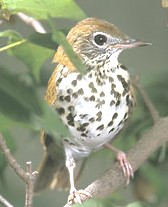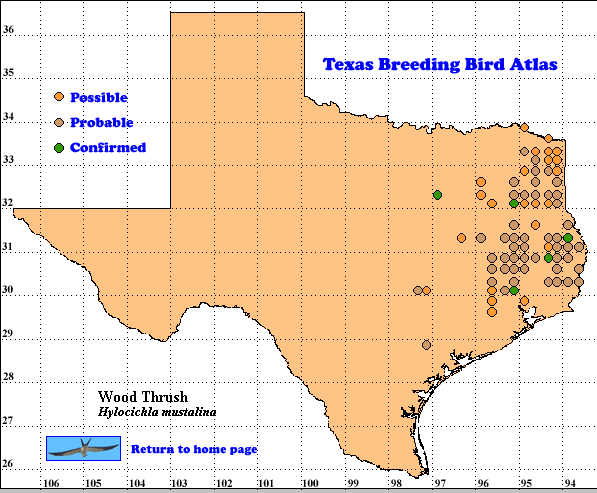Wood Thrush, a characteristic breeding bird in southern woods, reaches the southwest extent of its breeding range in east Texas. Although concerns were high a decade ago over population declines of this species, particularly along the Atlantic Coast, current trend estimates (see Status) suggest a much slower decline, reassuring for those who enjoy hearing and seeing this thrush (Roth et al. 1996, Sauer et al. 2005).
In winter Wood Thrushes are found in Middle America in habitats similar to the moist woodlands in which they breed (Howell and Webb 1995)…
DISTRIBUTION. During the 1987-1992 field work seasons of the TBBA project, atlasers found most confirmed and probable reports in the Pineywoods region of east Texas (see the region map in Lockwood and Freeman [2004]). Atlasers found 5 confirmed, 100 probable and 48 possible records. The distribution on this map agrees with that on a map of relative abundances derived from North American Breeding Bird Survey (BBS) data which indicates an average of 1-3 Wood Thrushes detected on many of the 16 BBS routes in Texas on which this thrush was found (Sauer et al. 2005).
In eastern North America BBS data show the highest breeding densities in a band extending southwest from New York and southern New England to east Texas (Sauer et al. 2005). Wood Thrushes winter in coastal areas of Middle America from Mexico to Panama (Roth et al. 1996).
SEASONAL OCCURRENCE. Northbound Wood Thrushes arrive in Texas between March 1 and June 6 with most reaching this state between early to mid-April to early May. Breeding occurs from mid-April probably to late July. Southbound migrants are present from August 29 to December 5 with most departing from mid-September to mid- November (Oberholser 1974, Lockwood and Freeman 2004).
BREEDING HABITAT. Wood Thrushes breed in Texas from near sea level to about 200 m (600 ft) elevation in heavy deciduous and mixed woodlands and thickets, including riparian areas and swamps (Oberholser 1974). This thrush also breeds in parks and gardens, placing its nest, built by the female in about 5 days, on a horizontal limb at an average of 3 m (10 ft; range 2-15 m [6-50ft])) above ground. The firm, compact cup is built of grasses, leaves, bark and moss, mixed with leaf mold and mud. The presence of leaves and lining of rootlets and its smaller size distinguish this nest from that of American Robin (Turdus migratorius; Harrison 1979, Roth et al. 1996).
In this cup the female usually lays 3-4 (range 2-5) smooth, unmarked turquoise-green eggs, She usually incubate the eggs for 13 (range 11-14 days and the young birds generally leave the nest 12-15 days after hatching.. Two broods per season are typical with some pairs attempting three. Rates of brood parasitism by Brown-headed Cowbird (Molothrus ater) vary geographically, ecologically and temporally from 10-100% (Harrison 1979, Roth et al. 1996).
STATUS. No striking difference is apparent between the TBBA map and the breeding and summer observations on the map in Oberholser (1974). Lockwood and Freeman (2004) report Wood Thrushes are uncommon to locally common in the Pineywoods region. BBS data for the period 1980-2005 suggest a yearly population change of about -1.3%, similar to the statistically significant trend of -1.5% for the same period derived from 1679 BBS routes in the United States and Canada on which this thrush was detected (Sauer et al. 2005).
Text by Robert C. Tweit (2007)
Literature cited.
Harrison, H. H. 1979. A field guide to western birds’ nests. Houghton Mifflin, Boston, MA.
Howell, S. N. G. and S. Webb. 1995. A guide to the birds of Mexico and northern Central America. Oxford University Press, New York.
Lockwood, M. W. and B. Freeman. 2004. The TOS handbook of Texas birds. Texas A&M University Press, College Station.
Oberholser, H. C. 1974. The bird life of Texas. University of Texas Press, Austin.
Pyle, P. 1997. Identification guide to North American birds, part 1. Slate Creek Press, Bolinas, CA.
Roth, R. R., M. S. Johnson and T. J. Underwood. 1996. Wood Thrush (Hylocichla mustelina). In The birds of North America, No. 246 (A. Poole and F. Gill, eds.). The Birds of North America, Inc., Philadelphia, PA.
Sauer, J. R., J. E. Hines, and J. Fallon. 2005. The North American Breeding Bird Survey, results and analysis 1966-2005. Version 6.2 2006. USGS Patuxent Wildlife Research Center, Laurel MD < http://www.mbr-pwrc.usgs.gov/bbs>

